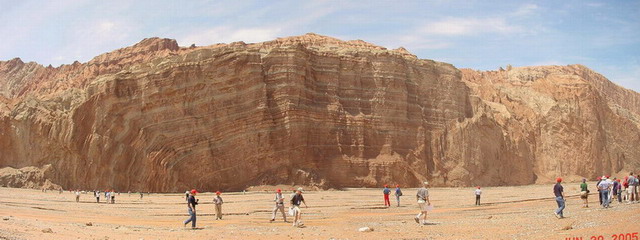
The fold plunge near the Quilitak Anticline
秋里塔格背斜附近的褶皺傾沒, 南疆
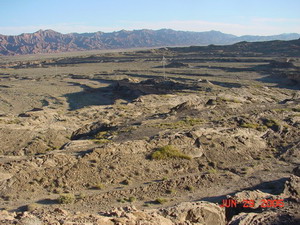
Minor Faults and offset layers of the East Quilitak Anticline, south Xinjiang
次要斷層與錯動岩層, 東秋里塔格背斜, 南疆
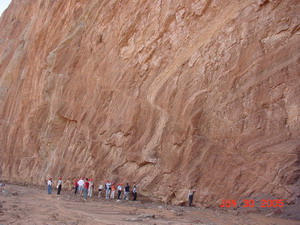
Alluvial terraces on both banks of Kuitunhe River, Kuytun, North Xinjiang
奎屯河兩岸沖積階地,
奎屯, 北疆
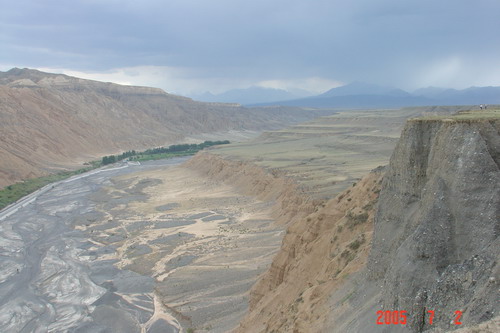
To see more photos, please visit My
Album > 2005Tianshan
如欲欣賞更多照片, 請到 我的相簿My Album
> 2005Tianshan
This conference is indeed one of the most unforgettable ones that I have ever attended. The field trip to Tienshan is definitely the major reason, but the meeting itself in Beijing is interesting enough.
One of the main topic in this conference is about detachment folding. During the opening remark, Professor John Suppe mentioned his recent ideas about detachment folding. It seems that it has wider applications in various tectonic settings than I had thought of before; many other recent studies also presented data with amazing quality to prove the general existence of detachement folds. Actually, I also presented in my poster two cross sections about the Chuhuangkeng Anticline, which has been previously proposed as a detachement fold by Hung in 1993. I also thought about the way other adjacent structures link to this detachement fold, and some of the likages are very similar to the idea "roof faulting" presented by Prf. Suppe. Actually, he stood in front of my poster and looked at it for several breath-taking minutes, and finally said "interesting..." I am so curious about what he did mean. But anyway, this is still an inspiring moment. Although I know without any dating, I still cannot propose any dynamic model, and there are some problems remained in my terrace correlation, but the stimuli in this conference encouraged my determination to keep working on this project.
As for the field, well, no word can really express the feeling of the first sight to the barren topography and giant standing anticlines. I believe they are the dream of all geologist. Xinjiang is a very wildly yet delicately designed classroom for both structural geology and active tectonics. I used to think Xinjiang is alreay a neotectonically silent region, but this time I learned that this area underwent huge deformation in the Quaternary.
Another thing to memorize is that I met so many old and new friends in this meeting, including Richard Walker, a sunny British post-doc, and Takashi Azuma, Professor Yoko Ota's former student, both of whom I also met in January Hokudan International Conference; Tatsuya Ishiyama, whose poster Wangyu and I have seen in 2002 AGU Fall Meeting; Li-Fang Yu and Ramon Gonzalez-Mieres, probably Prf. Suppe's last two PhD students; Richard Heermance, Prf. Burbank's student who used to work for the pilot core of TCDP in Taiwan. It is also funny to see the faces of many celebrities at the same time: Suppe, Mitra, McClay, John Shaw, Avouac, Aurelia, Karl and so on. I just wonder why Jay Namson did not show up?
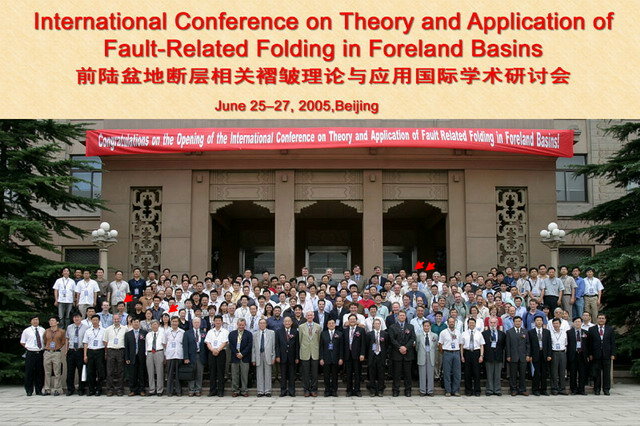
Red Arrows from left to right: Wangyu, I, Egg, YG
紅箭頭從左到右: 王昱, 我, 鹹蛋, 老師
[High
Resolution高解析度]
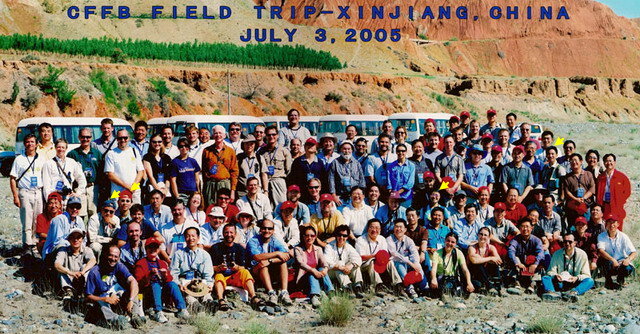
Yellow Arrows from left to right: YG, Egg, I, Wangyu
黃箭頭從左到右: 老師, 鹹蛋, 我, 王昱
[High
Resolution高解析度]